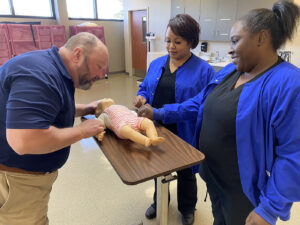(WACO, Texas) – Halloween is a time for children to dress up as their favorite characters while making their way around the neighborhood collecting candy. It is also a time that parents worry about the dangers of getting treats from people who they do not know very well.
Texas State Technical College’s Culinary Arts and Vocational Nursing programs recently offered some safety tips for parents to use when their children return home with the goodies.
According to a survey by the National Retail Federation, consumers are expected to spend more than $3 billion on Halloween candy this year. The survey also indicated that more than 60% of people will hand out candy this year.
Martha Rivera, lead instructor in the Culinary Arts program at TSTC’s Waco campus, said homemade items being given out for Halloween need to have a list of allergens that are ingredients. The U.S. Food and Drug Administration lists nine allergen groups; some of the ones applicable to holiday treats are eggs, milk, peanuts and tree nuts.
Parents need to go through candy before letting their children have it, Rivera said. She said to look for expiration dates and damage to wrappers. Anything that there is a doubt about should be thrown out, Rivera said.
Rivera said parents need to avoid giving young children hard candy, or even candy that has a hard outside and a soft inside. She said the safest candy to give to young children is something that melts quickly.
Syerra Taylor, a first-semester Vocational Nursing student at TSTC’s Sweetwater campus, had additional advice for parents.
“Do not let your children sneak off to their room at 11 p.m. and eat all the candy,” she said. “Put it up after the initial treats are enjoyed.”
Jim Bryant, a Vocational Nursing instructor, said parents should look for signs to see if their child is choking.
“Call out the child’s name and if they do not respond, that is the time to see if they are choking,” he said.
According to the American Red Cross, if a child does not respond and is not breathing or only gasping, immediately begin CPR, starting with compressions. Continue giving sets of 30 chest compressions and two breaths until you notice an obvious sign of life or a trained professional is on the scene.
Rivera said the Food Allergy Research and Education (FARE) organization’s Teal Pumpkin Project is an alternative for children who have allergies but can still participate in Halloween. People who have teal-colored pumpkins outside their doors indicate that non-candy items like bookmarks, crayons, glow sticks and other small items can be given out. People can register on FARE’s Teal Pumpkin Project page to take part.
For more information about TSTC, visit tstc.edu.

